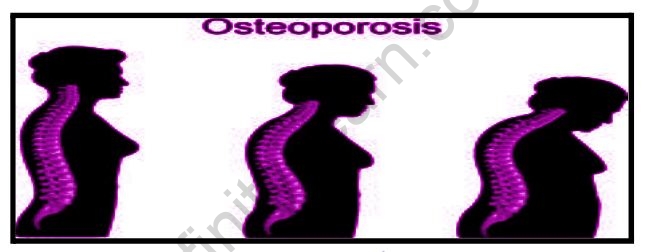Table of Contents
The name Osteoporosis means “bone marrow.” Osteoporosis causes bone loss that puts a person at greater risk for uncertain bone fractures. Osteoporosis is known as bone loss and loss of energy. This health disorder usually progresses without causing any discomfort or symptoms and is not diagnosed until the bone weakness causes severe bone fractures.

Osteoporosis is a condition that affects the bones in the human body. Its name is derived from the Latin word for “holes with holes.”
A healthy bone has few gaps, such as a honeycomb. However, Osteoporosis is a condition in which these gaps extend into these bones, causing the bone to lose strength and strength. This, in turn, makes the outer surface of the bone more vulnerable and thinner.
Overview
Osteoporosis makes bones weak and fragile – so weak that a fall or even slight discomfort, for example, a twist or just a cough, can cause fractures. Osteoporosis-related breaks usually occur in the hip, wrist, or spine.
Osteoporosis can occur in people of all ages, but it is more common in the elderly, especially women. More than 53 million people in the United States have osteoporosis or are at high risk for it.
People with Osteoporosis are at greater risk for fractures. A broken bone can be caused by performing routine exercises such as standing or walking. The bones are most affected by the ribs, hips, and bones of the wrists and spine.
Exercise, medication, a healthy diet, and weight loss work can prevent bone loss or help strengthen weakened bones.
Symptoms of Osteoporosis
The early stages of Osteoporosis do not show any signs or symptoms.
Some of the symptoms of Osteoporosis are the following:
- Decreasing gums
- Not weakened to hold
- Weak nails
- People who do not have any of these symptoms but who have a family background of people with Osteoporosis are also at equal risk and should consult a physician for treatment.
Osteoporosis Problems:
Osteoporosis occurs when too many bones are lost, and changes occur in the bone structure. Certain risk factors may lead to the development of Osteoporosis.
Age factor:
As you grow older, bone loss occurs faster, and new bone growth slows down. Over time, your bones may become weaker, and your risk of osteoporosis increases.
The body reaches the peak bones at age 30, and after 24-25 years of age, this cycle of bone formation slows down.
Food Features:
Apart from this, there are certain dietary factors that have led to the development of Osteoporosis in recent years. Includes:
Low calcium diets: People who eat less calcium are more likely to develop Osteoporosis as soon as bone density starts to decrease quickly.
Special Eating Habits: People who are very selective and limit themselves o with a limited diet or theta are underweight and see a higher rate of Osteoporosis cases in both men and women.
Intestinal Surgery: Surgery performed to lose weight, or other intestinal disorders may lead to Osteoporosis.
Problems Caused by Osteoporosis
Fractures of the bones, especially in the spine or pelvis, are a real problem for Osteoporosis. In addition, a fall can easily cause a hip fracture if Osteoporosis conditions are already present. This can lead to loss of mobility or even serious injury or death if the fracture is large.
Sometimes, a spinal fracture can occur regardless of the fall. This is because the bones that make up your spine can be very weak for some reason. It can cause back pain, loss of height, and forward-curved posture.
Examples and Types of Osteoporosis
Osteoporosis is a condition that many people experience sooner or later in life. According to a recent study from the International Osteoporosis Foundation, worldwide, one in three women over the age of 50 and one in 5 men experience Osteoporosis in their lifetime.
Here are some examples of Osteoporosis:
Basic Osteoporosis
Primary Osteoporosis is a highly reported case. However, many elements add to its darkness, for example, age, nutrition, and level of activity. Sex is another thing, as Osteoporosis is more common in women than men.
As the bones reach their prime, when they reach the age of 30, decay continues. This occurs as an aid to lowering hormone levels, primarily testosterone (which helps in bone growth) and estrogen.
Second Osteoporosis
Secondary Osteoporosis is similar to Primary Osteoporosis, the only difference being that secondary Osteoporosis occurs in response to other diseases that affect hormone levels within the body, for example, the thyroid. Although primary Osteoporosis may be responsible for ongoing changes in activity and diet levels, secondary Osteoporosis is usually treated with hormone replacement therapy and other more aggressive actions.
Osteogenesis Imperfecta
Osteogenesis imperfecta is a genetic disorder that affects about 6-7 people in every 100,000 people. It has eight known strains ranging from mild to severe cases and significantly affects bone health, making conditions appear similar to Osteoporosis.
This condition will usually have different symptoms, for example, respiratory problems, missing length, and unusually small ribs. Depending on the severity of the reaction, the bones may be broken repeatedly, even with minimal pressure. Additionally, related respiratory problems can shorten your life and all other illnesses that are found in the worst cases.
Idiopathic Juvenile Osteoporosis
This condition of the children has no known cause and usually begins just before puberty. Basically, it is a weak bone and can penetrate without other related symptoms and can often be resolved without clinical treatment over time.
If you are diagnosed with the condition, it is recommended that children monitor their physical activity and comply with their doctor’s rules in order to control the condition.
Osteoporosis: Signs and symptoms
Patients with Osteoporosis initially do not show any visible symptoms. However, as the disease progresses, more and more symptoms begin to develop. Some of these symptoms are:
Loss of Length
Under normal circumstances, weight loss is part of growth. The discs in your spinal cord shrink as you grow, thus causing loss of height. However, a person with this condition may suddenly lose height.
Broken wrists:
A broken wrist is one of the most obvious symptoms of Osteoporosis. Fracture of the wrist is most common in women after menopause. To stop the fall, the person usually shoots the arm forward as a reflex. A normal body with healthy bones should effectively withstand the magnitude of a normal fall. But a similar condition may cause a fracture, which may indicate Osteoporosis.
Broken hip:
A broken hip can cause severe, excruciating pain. The hip fracture is the upper part of the thigh bone. People in their 80’s and 90’s are at high risk for this type of injury. These injuries are most common after a fall. Many cases require surgery. The recovery process may be affected by the effects of aging.
Fracture:
A fracture can be a very serious symptom of this condition. Fractures can slow down and cause chronic or severe pain. Since fractures are not always visible, it may be difficult to link them to the disease. Fractures of the long bones may cause mobility problems and may require surgery.
Also read: Important Topic of Biology: Arthritis
FAQs
Q. What are the symptoms of Osteoporosis?
Ans: The signs or symptoms of Osteoporosis are as follows:
- Decreasing gums
- Not weakened to hold
- Weak nails
Q. What Causes Osteoporosis?
Ans: Osteoporosis can be caused by a number of factors, including:
- Low peak bone mass
- Both men and women have low levels of testosterone and estrogen
- Hormonal imbalances
- Thyroid diseases such as hyperthyroidism and others
- Anorexia, a kidney disease
- Surgical treatment of the ovaries to remove them
- Calcium deficiency in food
- Vitamin D deficiency







